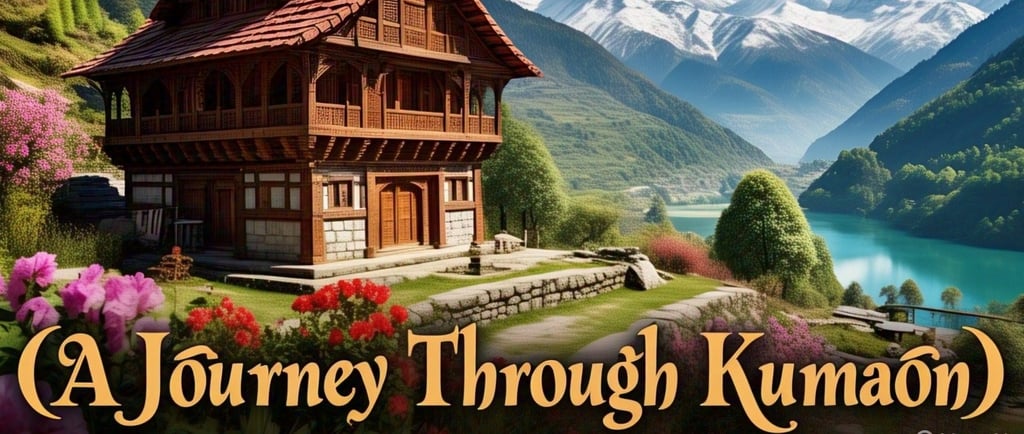🏔️ The Timeless Tapestry: Unfolding the History of Kumaon, Uttarakhand
From ancient dynasties and mythological tales to colonial influence and independence movements — the history of Kumaon is as rich and layered as its landscapes.
Rahul Singh
6/23/20252 min read


Nestled in the lap of the mighty Himalayas, Kumaon is one of the two majestic divisions of Uttarakhand, the other being Garhwal. While travelers today are drawn to its serene hill stations like Nainital, Almora, and Mukteshwar, few realize the profound historical and cultural legacy this region carries. From ancient dynasties and mythological tales to colonial influence and independence movements — the history of Kumaon is as rich and layered as its landscapes.
📜 1. The Ancient Roots – From Kurmanchal to Katyuris
Kumaon was once known as "Kurmanchal", named after the Kurma (tortoise) avatar of Lord Vishnu, who, according to Hindu mythology, is believed to have taken this form in the region. Archeological finds, including temple ruins and copper inscriptions, trace Kumaon’s roots back to prehistoric times.
By the 7th century CE, the Katyuri dynasty emerged as a powerful force, ruling over the unified region of Kumaon from their capital at Baijnath (then Kartikeyapura). They were great patrons of art and architecture, leaving behind temples that still dot the region — including those at Jageshwar, Baijnath, and Dwarahat.
👑 2. The Rise of the Chand Dynasty
After the decline of the Katyuris, the Chand dynasty took the reins around the 10th century CE. They moved their capital to Champawat, and later to Almora. The Chands played a pivotal role in shaping Kumaoni identity, encouraging literature, music, and temple architecture.
King Baz Bahadur Chand (1638–78) is especially remembered for building the Baleshwar Temple in Champawat and fortifying the region against invaders. The Chand era also marked administrative development and the growth of traditional Kumaoni culture, which remains vibrant to this day.
⚔️ 3. Gorkha Invasion and British Annexation
In the late 18th century, the expanding Gorkha Kingdom of Nepal invaded Kumaon. They ruled with an iron fist for over 24 years (1791–1815), imposing heavy taxes and suppressing local customs. However, discontent grew, and with support from the British East India Company during the Anglo-Nepalese War (1814–1816), the Gorkhas were defeated.
The Treaty of Sugauli in 1816 formally ceded Kumaon to the British, marking the beginning of British colonial rule in the region.
🏛️ 4. Kumaon Under British Rule
The British established Almora as the administrative capital of Kumaon. They introduced land reforms, English education, and missionary activities, some of which conflicted with traditional practices but also led to modernization.
Kumaon also became a hotbed for the Indian freedom movement, producing notable leaders like Govind Ballabh Pant, who later became India's first Home Minister. The region witnessed various satyagrahas and local uprisings, especially against forest laws and land policies imposed by the British.
🇮🇳 5. Post-Independence and Formation of Uttarakhand
After India gained independence in 1947, Kumaon remained part of Uttar Pradesh. But decades of neglect led to growing demand for a separate hill state, culminating in the formation of Uttarakhand on November 9, 2000.
Since then, Kumaon has continued to thrive as a cultural and ecological gem. It’s known for its Kumaoni language and folk music, rich traditions, festivals like Harela and Nanda Devi Mela, and unmatched natural beauty — making it a unique blend of history, heritage, and Himalayan mystique.
🌿 Final Thoughts
From ancient dynasties and spiritual legends to colonial upheavals and modern resurgence, the history of Kumaon is a compelling story of resilience, creativity, and cultural richness. As you walk through its pine forests or visit its ancient temples, you're not just witnessing nature’s splendor — you're also walking through thousands of years of heritage.
Whether you're a history buff, a culture seeker, or simply a traveler, Kumaon invites you to discover its stories etched in stone, scripture, and song.
Coming Soon
Experience tranquility in our boutique rental home.
Nature
Relax
contact@soulkumaon.com
+91-9876543210
© 2024. All rights reserved. Designed by Tronologic.
